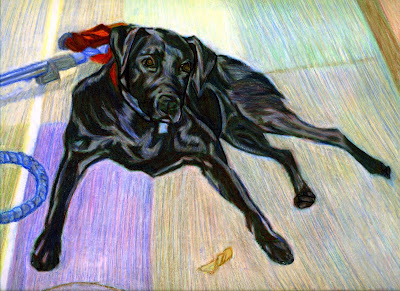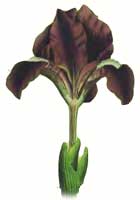For years I have been secretly fantasizing and intuiting, ways to think about traditional fine art and the new visual medium of the computer, since 1999 when I had my own aha moment. A moment that prompted me to go back to school and earn a degree in art. Due to the experiences of resistance I encountered in the academic environment, I have never given up on my fantasy since, even as I begin slow, tentative steps back into the studio.
Today, I have literally stumbled upon exactly that fine art and technology combination about which I had fantasized here:

This art form may help to show me (and other artists who are also interested) how I might be able to follow my fantasy more true; like an artist!
The artist/computer programmer,
San Base calls it: "The synergistic combination of programming and painting in Dynamic Painting," or "a generative art - an art that has been
generated algorithmically by a computer system."
In a way that I can very simply relate his working process is to the nature of graffiti artists painting over and over one another's works. Monsieur Base, says that, "Using the latest in computer technology, a still picture is transformed into a never-ending show that adds a whole new dimension to traditional Art. Images replacing each other hour by hour, day by day, month by month. None of the images repeat previous ones and will never repeat again. The picture living its own life with objects moving and transforming but still following the original artist's concept."
I noticed at once in his statement, "I'm a strong believer that innovation is often born when several drastically different disciplines come together," that his exact innovations may be speaking to those of us who have been searching for a meet point between the new and the old technologies in image-making!
Further, what San Base says about
the nature of looking at visual media, "The painting is always in the state of a perpetual transformation. It never repeats itself. Every time a new image is created, there is an opportunity for a peaceful receptivity and then the work disappears forever," is fascinating for me to think about!
The technology to make "Generative Art"happens generally this way:"using powerful video cards to generate real-time images." So, digging just a little deeper, I found Wikipedia has this to say about the process: Generative art refers to art that has been generated, composed, or constructed in an algorithmic manner through the use of systems defined by computer software algorithms, or similar mathematical or mechanical or randomised autonomous processes.
Generative art is a system oriented art practice where the common denominator is the use of systems as a production method. To meet the definition of generative art, an artwork must be self-contained and operate with some degree of autonomy. The workings of systems in generative art might resemble, or rely on, various scientific theories such as
Complexity science and
Information theory. The systems of generative artworks have many similarities with systems found in various areas of science. Such systems may exhibit order and/or disorder, as well as a varying degree of complexity, making behavioral prediction difficult. However, such systems still contain a defined relationship between cause and effect. Wolfgang Amadeus Mozart's "Musikalisches Würfelspiel" (Musical Dice Game) 1757 is an early example of a generative system based on randomness. The structure was based on an element of order on one hand, and disorder on the other.
An artist or creator will usually set down certain ground-rules or formulae and/or templates materials, and will then set a random or semi-random process to work on those elements. The results will remain somewhat within set limits, but may also be subject to subtle or even startling mutations. The idea of putting the art making process in the place of a pre-generated artwork is a key feature in generative art, highlighting the process-orientation as an essential characteristic. Generative artists such as Hans Haacke have explored processes of physical and biological systems in artistic context.
Generative art can also evolve in real-time, by applying feedback and generative processes to its own created states. A generative work of art would in this case never be seen to play in the same way twice. Different types of graphical programming environments (e.g. Max/Msp, Pure Data or vvvv) are used in real-time for generative audiovisual artistic expressions for instance in the Demoscene and in VJ-culture.
Artificial intelligence and automated behavior have introduced new ways of seeing generative art. The term behavior is particularly useful when describing generative qualities in art because of the associations to biology and evolution, for example with the virus models used by the digital artist Joseph Nechvatal. Autopoiesis by Ken Rinaldo includes fifteen musical and robotic sculptures that interact with the public and modify their behaviors based on both the presence of the participants and each other.
The term generative art is not describing any art-movement or ideology. It's a method of making art. The term refers to
how the art is made, and not taking into account why it was made or what the content of the artwork is."
That examples like:
"Composers such as John Cage and Brian Eno have used generative principles and systems in their works. Eno collaborated on the development of SSEYO's Koan generative music system and this software was used in the creation of the album Generative Music 1.
Cut-up technique by
Tristan Tzara and
William Burroughs, AARON by Harold Cohen, Conway's Game of Life, visual software by Scott Draves and Karl Sims, artwork by Sol LeWitt, and architectures by Celestino Soddu are examples of generative art in different disciplines. Philip Galanter has done good critical theoretical work and analysis of the field.
A specific research on unconventional algorithms to create paintings according to generative principles have been proposed by the Protoquadro project.
The Protoquadro project you ask is:
Protoquadro is a painting technique conceived to use digital supports to produce objects that will stand into a space as paintings used to be. It pertain to the realm of Generative art."

Protoquadro objects have some characters of a painting and some of a totally new class of objects, therefore the name, formed by the greek term "protos" (first) and the italian "quadro" (painting).
The project has been conceived by
Federico Bonelli (his comments appear in the comments section to
this post) and
Maurizio Martinucci in 2003, and developed thereafter through various collaborations. It produced a small number of protoquadro.
All of these ideas are based on the concept of transformation through Synchronicity. The painting has to evolve in time, this evolution has to be connected to the situation where it has been conceived and to the material chosen to compose it.
Existing Protoquadro are based on photographic material, a compositing idea and a rule of evolution.
Very relevant to the spirit of the existing objects have been the
Italian Futurist painter
Umberto Boccioni. He writes in his own book about painting:
"We synthesize all instants (of time, place, form, color-tone) and we build the painting upon them. And this painting, as an independent organism, has its own law, and the elements that made it obey to this law, creating as such, the similarity of the painting with itself" (
Umberto Boccioni,[Italian Futurist Painter and Sculptor, 1882-1916] 1914)
So far the algorithms invented and/or used for protoquadro have been:
NG# The NG# algorithms uses as a engine the geometrical properties of the
Enneagram symbol. The Enneagram is used to generate sequences of values according to a feedback process that involves the color on the canvas in some peculiar points and in some determined instants of time.
SATOR# The project SATOR involved a research on magic squares. The original protoquadro called SATOR used the property of a order 5 magic square to generate the flow of numbers necessary to control the painting evolution.
BOIDS# used for a multiscreen installation called Junglescape, a specific variation of the boids algorithm, agents that responding to varying parameters create a wondering flock. The flock is aware of the presence of someone in the vicinity and reacts to it, splitting if the presence are two or more. Brushes are generated according to the flock behavior and heuristic rules chosen to massimize aesthetic effects. The original algorithms for drawing boids was developed by Craig Reynolds in 1986, is an artificial life program, simulating the flocking behaviour of birds."
Art, Science and Mathematics merging in 21st Century Art!


 Good art makes us marvel… how? Great art makes us think… why? A key to Chase’s work is forcing the viewer to appraise - not only the spaces and situations around themselves but within themselves as well. Street Art since the early days of Graffiti in the “Boogie Down” Bronx has been sowing ideas in the subconscious of society. The Lower class sent out messages of innovation and creativity and gave hope. Where there was once only a desolate landcape filled with dreary dreams and tumultuous thought, grew an imagination and a voice.
Good art makes us marvel… how? Great art makes us think… why? A key to Chase’s work is forcing the viewer to appraise - not only the spaces and situations around themselves but within themselves as well. Street Art since the early days of Graffiti in the “Boogie Down” Bronx has been sowing ideas in the subconscious of society. The Lower class sent out messages of innovation and creativity and gave hope. Where there was once only a desolate landcape filled with dreary dreams and tumultuous thought, grew an imagination and a voice. With street artists such as Chase, we see a positive message taking root in the underground and bubbling over into our everyday society. Chase has had fine art exhibits all over the world, Belgium, NYC, and Los Angeles; but it’s his ability to connect with a society on the street level that gives his message the most meaning. People young and old are yearning for inspiration packaged in small easy identifiable messages such as some of Chase’s favorite mantra’s, ” Be the Change,” “You can’t until you say you can,” “be peace” and “seek truth: knowledge is power.”
With street artists such as Chase, we see a positive message taking root in the underground and bubbling over into our everyday society. Chase has had fine art exhibits all over the world, Belgium, NYC, and Los Angeles; but it’s his ability to connect with a society on the street level that gives his message the most meaning. People young and old are yearning for inspiration packaged in small easy identifiable messages such as some of Chase’s favorite mantra’s, ” Be the Change,” “You can’t until you say you can,” “be peace” and “seek truth: knowledge is power.”




















